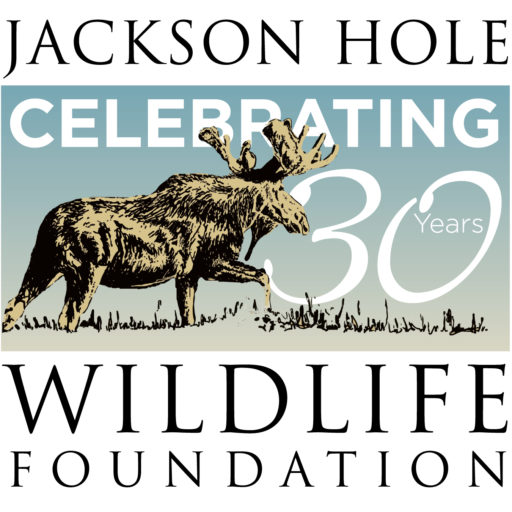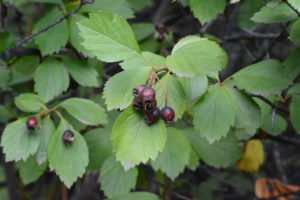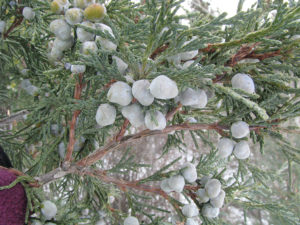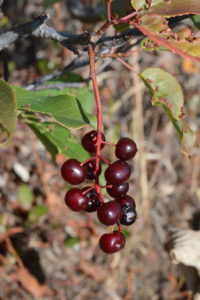
Choke Cherries are favorites of birds, bears and small mammals. Birds can become “tipsy” feeding on the fermenting, fall berries.
As wildflowers fade and grasses dry, wildlife depend on the more permanent presence of woody plants to get through the next several months. Lowly shrubs are key for survival. They offer up colorful fruits and still-green leaves and stems providing essential fats and carbs for bird for migration and mammal hibernation for winter. And dried fruits and bare twigs contain sustenance throughout winter for critters above ground.
Here are a just a few examples of shrub and animal connections. Research on which animals species use which plants is relatively sparse for our region. Your Nature Mapping observations noting what animals are using which shrubs and how are helpful information.
Bears eat berries. In summer huckleberries are a favorite and right now they are into hawthorns—the main reason for the recent closure of the Moose-Wilson Road. Of course bears consume many other fruits as well.
In late summer, thimbleberries stand out amidst broad green leaves that thrive in the moist shade of streamside forests. Once red, the raspberry-like fruits disappear within a day or two—who ate them? Perhaps birds, squirrels, chipmunks, but no one knows for sure.
In late summer, tanagers, grosbeaks, vireos, robins, and waxwings search hillsides and backyards for service berries, chokecherries, and now ripening hawthorns. In town they will look for planted crabapples (bears will too!). Red-stemmed dogwood fruits are particularly high in fats needed by migrating birds.
While some bird species will keep flying south, the local abundance of American Robins and Cedar Waxwings will depend on the amount of fruit persisting over winter. Rosehips are particularly durable. Leftover fruits come spring give an added boost to returning migrants.
Bright orange elderberry and mountain ash are particularly popular with birds, small mammals, bears, elk, and moose. Some people have said these berries are poisonous because they see so many untouched and often on the ground. Elderberries have a high alkaloid content—we people must always cook the berries first. However, they are preferred foods of many critters. Most likely, the plentitude of berries keeps them from all being consumed right away. Also, these fruits become more tasty with a frost or two which brings out the sugars. It is possible for birds to become tipsy on fermenting fruits.
Studies indicate that antioxidant compounds in polyphenol and anthocyanin rich fruits help reduce the extreme metabolic stress of migrating birds. Anthocyanins show up as a deep purple maroon color.
After the rut in late fall, moose congregate, often by the dozen, on Antelope Flats. They are eating the nutritious green leaves and twigs of antelope bitterbrush, not the pungent silver twigs of sagebrush.
Moose also depend on the cover and browse of willows stands. And as those with gardens know, moose will zero in on red-stemmed dogwoods and roses in the landscape.
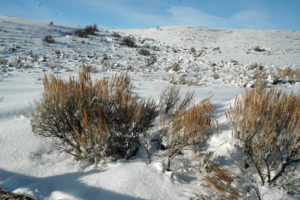
Sagebrush grows in abundance in Grand Teton National Park. Wintering moose, however, are largely grazing on the intermixed antelope bitterbrush.
Leaves and twigs, as well as the dense twiggy habit of sagebrush provide food and cover for greater sage-grouse winter long.
Bighorn sheep, along with deer and elk, will preferentially browse a low fuzzy shrub called winterfat on dry knolls. Winterfat contains 10% crude protein in winter.
Townsend’s Solitaire, related to robins, particularly savor the evergreen cover and bluish “berries” of juniper. So look for them on dry hill sides with an abundance of Rocky Mountain juniper, such as the flanks of Miller Butte.
All our wildlife depends on plants. Take a closer look at these connections, and please keep on Nature Mapping!
By Frances Clark
Frances will be presenting a program on “Teton Shrubs: ID Tips and Wildlife Values” Tuesday, Sept. 24, at 6 p.m. on at the Teton County Library.
